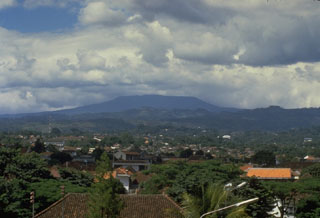Report on Tangkuban Parahu (Indonesia) — October 1983
Scientific Event Alert Network Bulletin, vol. 8, no. 10 (October 1983)
Managing Editor: Lindsay McClelland.
Tangkuban Parahu (Indonesia) Seismicity continues to increase
Please cite this report as:
Global Volcanism Program, 1983. Report on Tangkuban Parahu (Indonesia) (McClelland, L., ed.). Scientific Event Alert Network Bulletin, 8:10. Smithsonian Institution. https://doi.org/10.5479/si.GVP.SEAN198310-263090
Tangkuban Parahu
Indonesia
6.77°S, 107.6°E; summit elev. 2084 m
All times are local (unless otherwise noted)
Seismicity continued to increase through mid-October but no surface changes have been noted. Tectonic earthquakes and both A-and B-type microtremors were recorded. A-type events occurred irregularly, usually at 1-3 per day, but as many as five were detected on several days. B-type earthquakes increased substantially, as shown in table 1.
Table 1. Number of B-type events/day at Tangkubanparahu, May to mid-October 1983.
| Time Period | Daily Average | Maximum / day |
| May-Jul 1983 | 3 | 7 |
| Aug 1983 (first weeks) | 10 | 19 |
| Aug 1983 (last week) | 14 | 25 |
| Sep 1983 (first half) | 70 | 120 |
| Sep 1983 (second half) | 57 | 103 |
| Oct 1983 (first half) | 72 | 127 |
Ground deformation did not show regular changes. From 10 to 25 mm of irregular inflation and deflation were detected but their significance is doubtful. Fumarole temperatures remained stable at 96°C in the three fumarole fields (Baru, Ratu, and Upas). The previously declared forbidden zone of 3-km-radius remained in effect.
Geological Summary. Gunung Tangkuban Parahu is a broad stratovolcano overlooking Indonesia's former capital city of Bandung. The volcano was constructed within the 6 x 8 km Pleistocene Sunda caldera, which formed about 190,000 years ago. The volcano's low profile is the subject of legends referring to the mountain of the "upturned boat." The Sunda caldera rim forms a prominent ridge on the western side; elsewhere the rim is largely buried by deposits of the current volcano. The dominantly small phreatic eruptions recorded since the 19th century have originated from several nested craters within an elliptical 1 x 1.5 km summit depression.
Information Contacts: A. Sudradjat, VSI.

